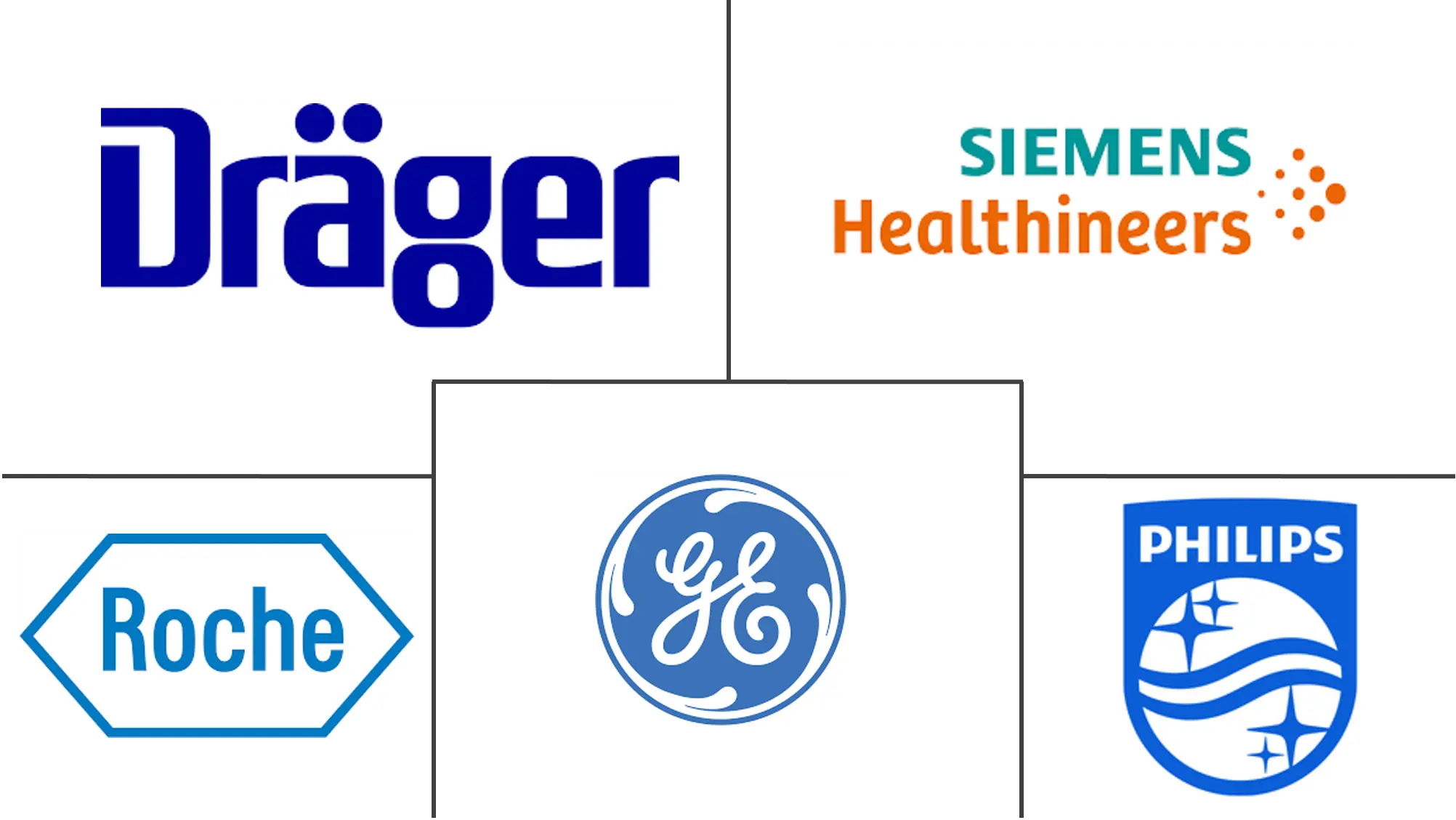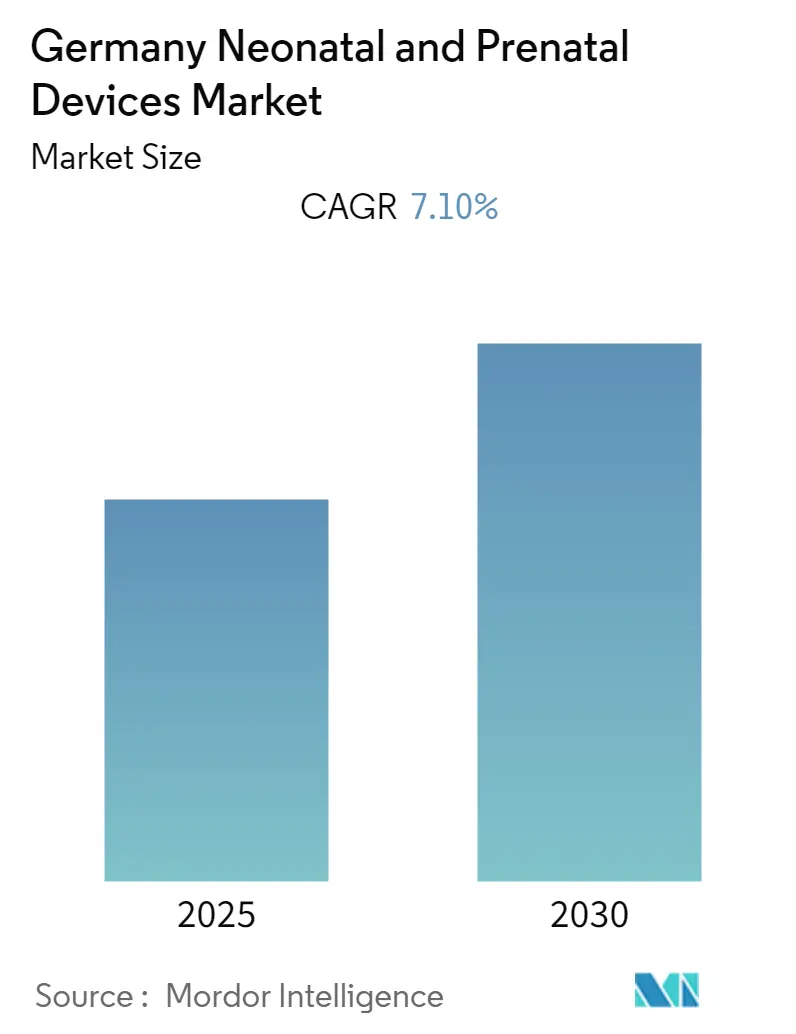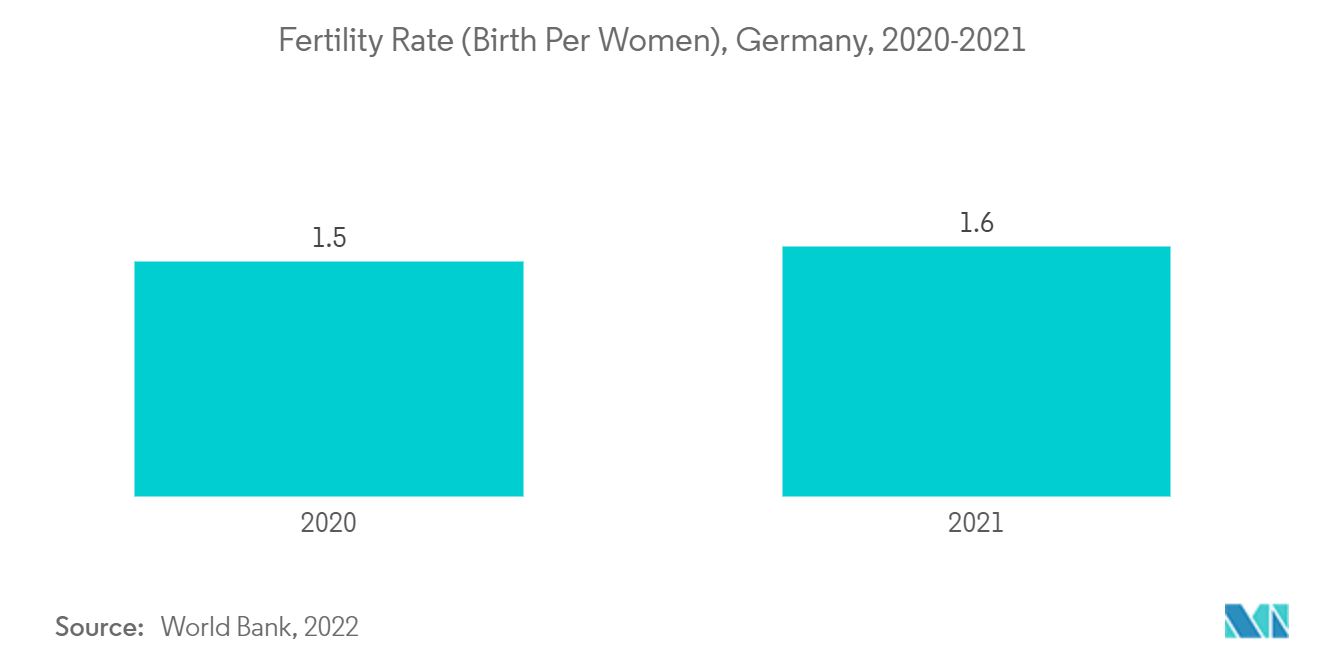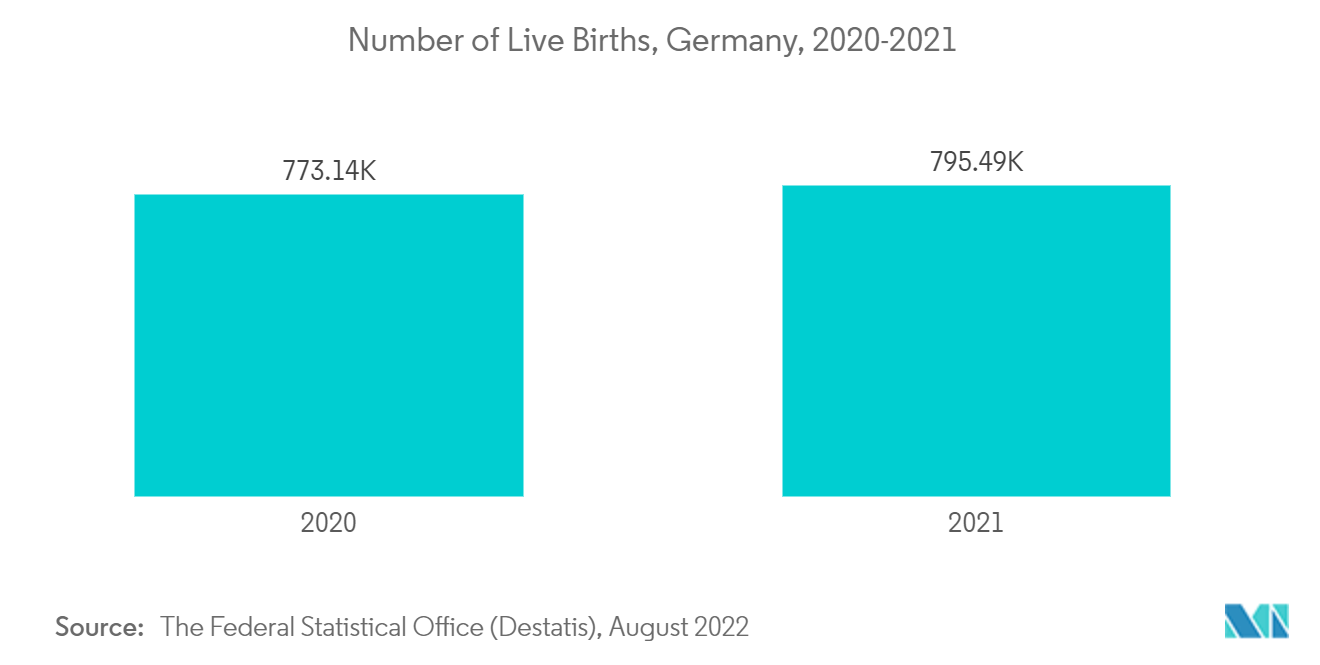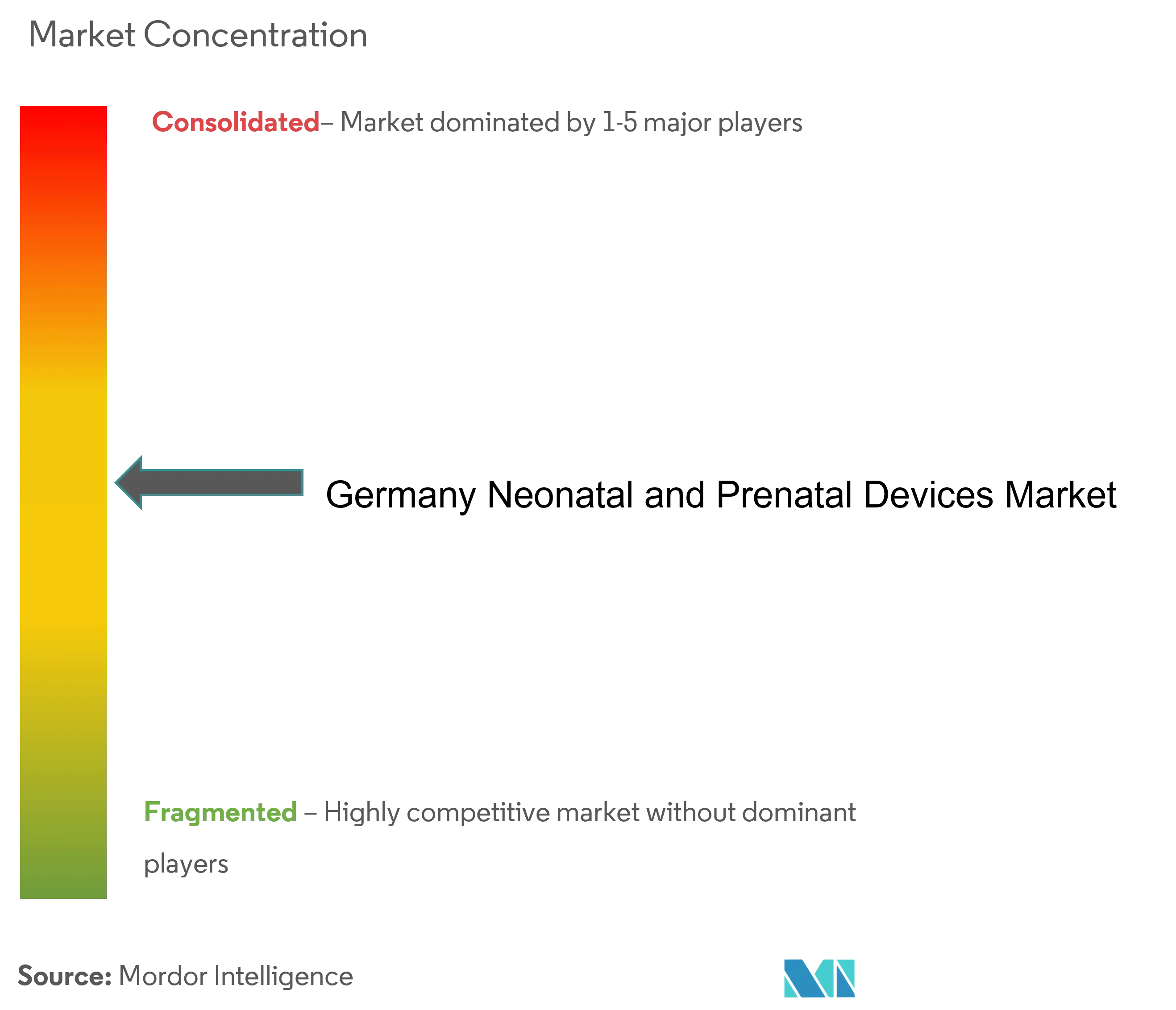Germany Neonatal & Prenatal Devices Market Analysis
The Germany Neonatal and Prenatal Devices Market is expected to register a CAGR of 7.1% during the forecast period.
The COVID-19 pandemic has significantly impacted the neonatal and prenatal devices market. For instance, according to the study published in the Journal of Reproductive and Infant Psychology in December 2021, the overall maternal mental health, newborn perceptions, and early caregiving during the initial stages of the COVID-19 pandemic did not alter significantly from pre-pandemic perspectives. However, with the onset of the COVID-19 cases, lockdowns and fear of contamination were the leading causes of delayed health-seeking, resulting in problematic pregnancies. COVID-19 infection during pregnancy raises the risk of pregnancy complications such as preterm birth, early rupture of the membranes, and, in rare cases, maternal mortality. As a result, the market was significantly impacted during the COVID-19 pandemic. However, since the restrictions were lifted, the industry has been recovering well. Over the last two years, the market recovery has been led by the rise and the risk of pregnancy complications and new product launches by market players.
The market's growth factors include an increasing number of preterm and low-weight births, growing technological advancement in infant and maternal care products, and rising congenital and pregnancy complications due to a sedentary lifestyle. Preterm babies often require special care in the neonatal intensive care unit (NICU) which created a demand for neonatal devices. According to the Statistisches Bundesamt (Destatis) 2022, there were 3,420 stillborn children in Germany in 2021 which equates to 4.3 stillbirths for every 1,000 births. Also, according to the federal statistical office (destatis), the rate had been trending slightly upward since 2010, after reaching an all-time low of 3.5 stillbirths per 1,000 births in 2007. In both 2020 and 2019, 4.1 children out of 1,000 births were stillborn. The growing incidence of stillbirths in the country is expected to increase the demand for neonatal and prenatal devices, thereby boosting market growth.
Besides, various strategies adopted by the market players are also contributing to the market growth. For instance, in November 2020, Natus Medical acquired the neonatal healthcare equipment company Baby. Additionally, in May 2020, Drägerwerk AG & Co. KGaA launched Evita V600 and V800, and Babylog VN600 and VN800 to facilitate the intensive care ventilation of adults to premature babies, with an operating concept designed to enable flexible orientation and to provide clearer user guidance.
While the market is expected to experience a boost, the rising cost of neonatal care is one of the major factors hindering the Germany neonatal and prenatal devices market growth.
Germany Neonatal & Prenatal Devices Market Trends
Incubators Segment is Anticipated to have a Highest Share in the Studied Market Over the Forecast Period
An incubator is an apparatus used to maintain environmental conditions suitable for a neonate (newborn baby). It provides a safe, temperature-controlled environment for a baby that needs NICU care. Neonatal incubators are often necessary for infants. Some low birth-weight infants need respiratory support ranging from extra oxygen (by the head hood or nasal cannula) to continuous positive airway pressure (CPAP) or mechanical ventilation. The temperature regulation of infants is among the major factors to be controlled in neonatal incubator cases. The companies have varied devices on several parameters, among which temperature regulation is very important, as severe temperature differences lead to neonate heat loss, hypothermia, and apnea, which are closely related to airflow and air velocity.
The rise in preterm and low-weight birth drives the segment. For instance, according to the study published by BMC Pregnancy and Childbirth in February 2021, the median gestational age for preterm birth is 32.3 weeks, and 6.1% of babies were born weighing less than 2500 g in 2020. It also stated that birth weights less than the 10th percentile for gestational age were found in 8.5% of the total cohort in the German population in 2020.
Every year numerous studies related to neonates are carried out in the country by the German Neonatal Network, funded by the German Ministry of Education and Research to understand the improvements in prenatal care. One such study was undertaken in the year 2020 to understand the survival rates of preterm infants obtaining active perinatal care, in 43 Level III NICUs across Germany. Such initiatives highly facilitate the adoption of neonatal and prenatal care equipment within hospitals.
Ultrasound and Ultrasonography Devices are Expected to Hold a Significant Market Share Over the Forecast Period
A fetal ultrasound (sonogram) is an imaging technique that uses sound waves to produce images of a fetus in the uterus. Fetal ultrasound images can assist a healthcare provider in evaluating the baby's growth and development and monitoring the pregnancy. Fetal ultrasonography is sometimes used to evaluate potential abnormalities or to confirm a diagnosis.
The availability of technologically advanced products in the market also contributes to market growth. For instance, 3D ultrasound allows doctors to evaluate internal and exterior fetal anatomy using static 3D images. Also, 4D ultrasound has recently been introduced in medical practice and complements 2D and 3D examination by obtaining images in real time. During a 4D ultrasound, the practitioner can broadcast footage of anatomical images. This allows healthcare personnel to observe the function of the fetal heart wall and valves and blood flow through various veins.
Also, a study published in the Journal of BMC Pregnancy and Childbirth in April 2022 reported that ultrasound findings help in the prenatal diagnosis of Wolf-Hirschhorn syndrome in Germany. In the study, all women underwent a complete fetal abnormality examination, which included fetal echocardiography using high-resolution ultrasound equipment to detect Wolf-Hirschhorn syndrome in the fetus. The advantages of ultrasonography in detecting fetus abnormality and various diseases diagnosis are expected to propel the segment's growth over the forecast period.
Germany Neonatal & Prenatal Devices Industry Overview
The German neonatal and prenatal devices market studied is consolidated owing to the presence of various small and large market players. Companies like Dragerwerk AG & Co. KGaA, GE Healthcare, Siemens Healthineers AG., and Hoffmann-La Roche Ltd, among others, hold substantial shares in the fetal and neonatal care equipment market. Some strategies implemented include agreements, collaborative models, business expansion, and product developments.
Germany Neonatal & Prenatal Devices Market Leaders
-
Dragerwerk AG & Co. KGaA
-
F. Hoffmann-La Roche Ltd
-
GE Healthcare
-
Siemens Healthineers AG
-
Koninklijke Philips N.V.
- *Disclaimer: Major Players sorted in no particular order
Germany Neonatal & Prenatal Devices Market News
- In January 2022, Freudenberg Medical created a skin-friendly monitoring belt in collaboration with a pediatrician and a neonatologist. The belt is made of a narrow band wrapped around the baby's chest, and sensors transfer signals to a portable monitor. The band allows for easy monitoring of the heart's electrical activity as well as the measurement of respiratory activity. Dry electrodes are used in the belt, constructed of skin-friendly silicone.
- In November 2021, aXcent medical GmbH launched a fully electronic anesthesia workstation called APUS x3. It has a user-friendly interface design and provides every ventilation mode suitable for adult, pediatric, and neonate patients.
Germany Neonatal & Prenatal Devices Industry Segmentation
Neonatal monitoring devices are vital tools routinely used in gynecology and obstetrics interventions to examine fetal health during labor and delivery. These devices are extensively used in neonatal intensive care units (NICUs), where complex machines and monitoring devices are designed for the unique needs of newborn babies. The Germany Neonatal and Prenatal Devices Market is segmented by Product Type (Prenatal and Fetal Equipment (Ultrasound and Ultrasonography Devices, Fetal Doppler, Fetal Magnetic Resonance Imaging (MRI), Fetal Heart Monitors, Fetal Pulse oximeters, Other Prenatal and Fetal Equipment), and Neonatal Equipment (Incubators, Neonatal Monitoring Devices, Phototherapy Equipment, Respiratory Assistance and Monitoring Devices, Other Neonatal Care Equipment). The report offers the value (in USD million) for the above segments.
| By Product Type | Prenatal and Fetal Equipment | Ultrasound and Ultrasonography Devices | |
| Fetal Doppler | |||
| Fetal Magnetic Resonance Imaging (MRI) | |||
| Fetal Heart Monitors | |||
| Fetal Pulse oximeters | |||
| Other Prenatal and Fetal Equipment | |||
| Neonatal Care Equipment | Incubators | ||
| Neonatal Monitoring Devices | |||
| Phototherapy Equipment | |||
| Respiratory Assistance and Monitoring Devices | |||
| Other Neonatal Care Equipment | |||
Germany Neonatal & Prenatal Devices Market Research FAQs
What is the current Germany Neonatal and Prenatal Devices Market size?
The Germany Neonatal and Prenatal Devices Market is projected to register a CAGR of 7.1% during the forecast period (2025-2030)
Who are the key players in Germany Neonatal and Prenatal Devices Market?
Dragerwerk AG & Co. KGaA, F. Hoffmann-La Roche Ltd, GE Healthcare, Siemens Healthineers AG and Koninklijke Philips N.V. are the major companies operating in the Germany Neonatal and Prenatal Devices Market.
What years does this Germany Neonatal and Prenatal Devices Market cover?
The report covers the Germany Neonatal and Prenatal Devices Market historical market size for years: 2021, 2022, 2023 and 2024. The report also forecasts the Germany Neonatal and Prenatal Devices Market size for years: 2025, 2026, 2027, 2028, 2029 and 2030.
Our Best Selling Reports
Germany Neonatal and Prenatal Devices Industry Report
Statistics for the 2025 Germany Neonatal and Prenatal Devices market share, size and revenue growth rate, created by Mordor Intelligence™ Industry Reports. Germany Neonatal and Prenatal Devices analysis includes a market forecast outlook for 2025 to 2030 and historical overview. Get a sample of this industry analysis as a free report PDF download.

